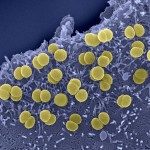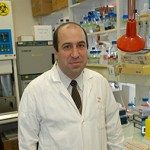Link to Pubmed [PMID] – 9680205
Mol. Microbiol. 1998 Jun;28(6):1153-63
Pilus-mediated adherence makes an essential contribution to the pathogenesis of Neisseria meningitidis by allowing the initial localized adherence. Pili are assembled from a protein subunit called pilin. Two proteins, PilC1 and PilC2, are also key elements in the formation of pili as the production of at least one PilC protein is required for pilus assembly. In addition, PilC1 but not PilC2 modulates adhesiveness, most probably by being the adhesin. Recently, both genes have been demonstrated to be controlled by different promoters, pilC2 is expressed from a single transcription starting point (TSP), whereas pilC1 has three TSPs. One of these, PC1.1, corresponds to the unique TSP of pilC2, and two others, PC1.2 and PC1.3, are located in a region upstream of pilC1 but not pilC2. This suggests that both genes may be under the control of separate regulatory pathways. In this work, by engineering pilC1-lacZ and pilC2-lacZ transcriptional fusions, we provide evidence that expression of pilC1, but not that of pilC2, is transiently induced by bacterial cell contact. This induction required viable cells, did not need the presence of pili and relied on the expression of pilC1 from PC1.3. Destruction of this TSP by site-directed mutagenesis did not significantly diminish the piliation level or the basal expression of PilC1, but led to the loss of cell contact-dependent upregulation of pilC1 and to a dramatic decrease in bacterial adhesiveness. Taken together, these data demonstrate that cell contact-dependent upregulation of the transcription of pilC1 at PC1.3 is essential for meningococcal pilus-mediated adhesion.

